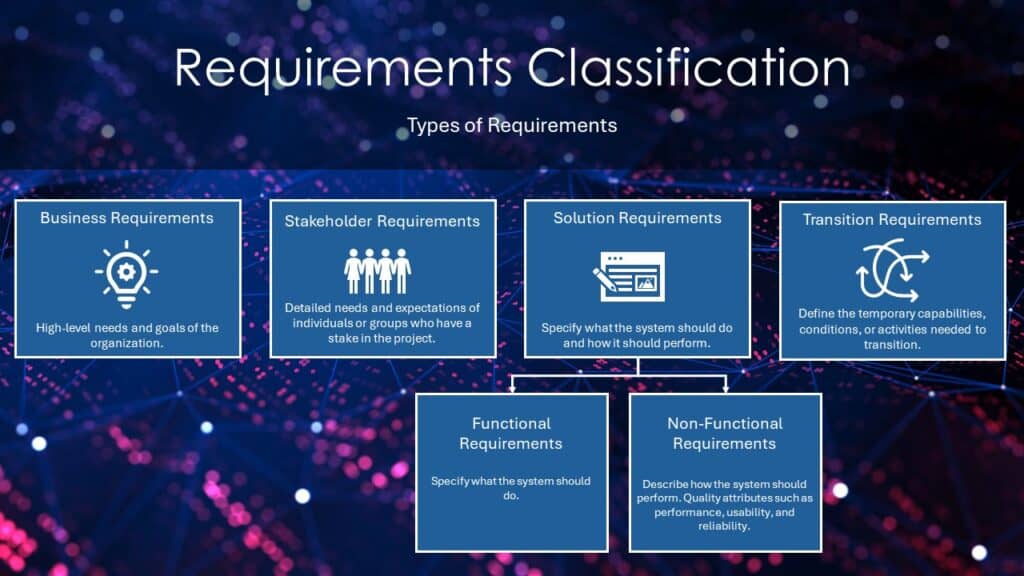As a business analyst, one of the most crucial aspects of your role is to define, gather, and manage requirements effectively. Clear and well-defined requirements are the foundation of a successful project, ensuring that the final product meets the needs of the business and its stakeholders. This guide explores four key types of requirements from a business analyst’s perspective: Business Requirements, Stakeholder Requirements, Solution Requirements, and Transition Requirements.
1. Business Requirements
Definition: Business requirements represent the high-level needs and goals of the organization that the project aims to achieve. These requirements are strategic, outlining what the organization aims to accomplish without delving into specific technical details.
Purpose: As a business analyst, your role is to ensure that the project aligns with the overall business strategy and objectives. Business requirements provide the foundation upon which all other requirements are built.
Examples:
- Increase online sales by 15% within the next fiscal year.
- Reduce customer service response time by 50%.
- Launch a new mobile banking app to attract younger customers.
Importance:
- Alignment: Ensures that the project supports the organization’s strategic goals.
- Clarity: Provides a clear understanding of the project’s purpose and expected outcomes.
- Guidance: Directs the development of more detailed requirements.
Role of a Business Analyst:
- Facilitate discussions with executives and key stakeholders to elicit business requirements.
- Document and validate these requirements to ensure they align with the organization’s strategic goals.
- Communicate the business requirements to the project team to provide clear direction.
2. Stakeholder Requirements
Definition: Stakeholder requirements are detailed needs and expectations of individuals or groups who have a stake in the project. These requirements bridge the gap between high-level business requirements and detailed solution requirements.
Purpose: Capturing stakeholder requirements ensures that the needs of all interested parties are considered and addressed in the project.
Examples:
- The marketing team requires real-time analytics to track campaign performance.
- Customers need a seamless and secure login process for the new app.
- The legal department requires the system to comply with data protection regulations.
Importance:
- Inclusivity: Ensures that the needs of all stakeholders are considered.
- Conflict Resolution: Helps identify and resolve conflicting needs and priorities.
- Engagement: Promotes stakeholder buy-in and support for the project.
Role of a Business Analyst:
- Conduct stakeholder interviews, surveys, and workshops to gather requirements.
- Create a stakeholder map to identify all relevant parties and their interests.
- Document and prioritize stakeholder requirements, ensuring they align with business goals.
3. Solution Requirements
Solution requirements can be divided into two categories: functional and non-functional requirements.
Functional Requirements
Definition: Functional requirements specify what the system should do. These are detailed descriptions of the system’s functionality, features, and behavior.
Purpose: Provide developers with clear instructions on what needs to be built.
Examples:
- The system must allow users to reset their passwords via email.
- The application should support multiple languages.
- The system must generate monthly financial reports.
Role of a Business Analyst:
- Collaborate with the development team to translate business and stakeholder requirements into functional specifications.
- Use techniques like use cases and user stories to describe functional requirements.
- Validate functional requirements with stakeholders to ensure accuracy and completeness.
Non-Functional Requirements
Definition: Non-functional requirements describe how the system should perform. These requirements specify quality attributes such as performance, usability, and reliability.
Purpose: Ensure that the system meets certain standards and user expectations for quality and performance.
Examples:
- The system should handle up to 10,000 concurrent users.
- The application must load within 3 seconds.
- The system should have an uptime of 99.9%.
Role of a Business Analyst:
- Identify and document non-functional requirements through discussions with stakeholders and technical teams.
- Ensure that non-functional requirements are included in project scope and plans.
- Monitor and validate that these requirements are met during testing and implementation.
4. Transition Requirements
Definition: Transition requirements define the temporary capabilities, conditions, or activities needed to transition from the current state to the desired future state. These requirements are only necessary during the transition phase.
Purpose: Ensure a smooth and effective transition from the old system or process to the new one.
Examples:
- Data migration from the legacy system to the new system.
- Training for staff on how to use the new software.
- Temporary support resources during the cutover period.
Importance:
- Continuity: Ensures business operations continue smoothly during the transition.
- Preparedness: Prepares the organization for the change, reducing risks and resistance.
- Efficiency: Facilitates a quicker and more efficient transition process.
Role of a Business Analyst:
- Identify transition requirements through analysis of the current and future states.
- Collaborate with IT and training teams to plan and execute transition activities.
- Monitor and manage the transition to ensure minimal disruption to business operations.
Conclusion
As a business analyst, your ability to define and manage different types of requirements is critical to the success of any project. Business requirements provide the strategic direction, stakeholder requirements capture specific needs, solution requirements define detailed functionality and performance, and transition requirements ensure a smooth shift to the new system. By addressing each type of requirement, you can ensure that the final product meets the needs of the business and its stakeholders, leading to successful project outcomes.

